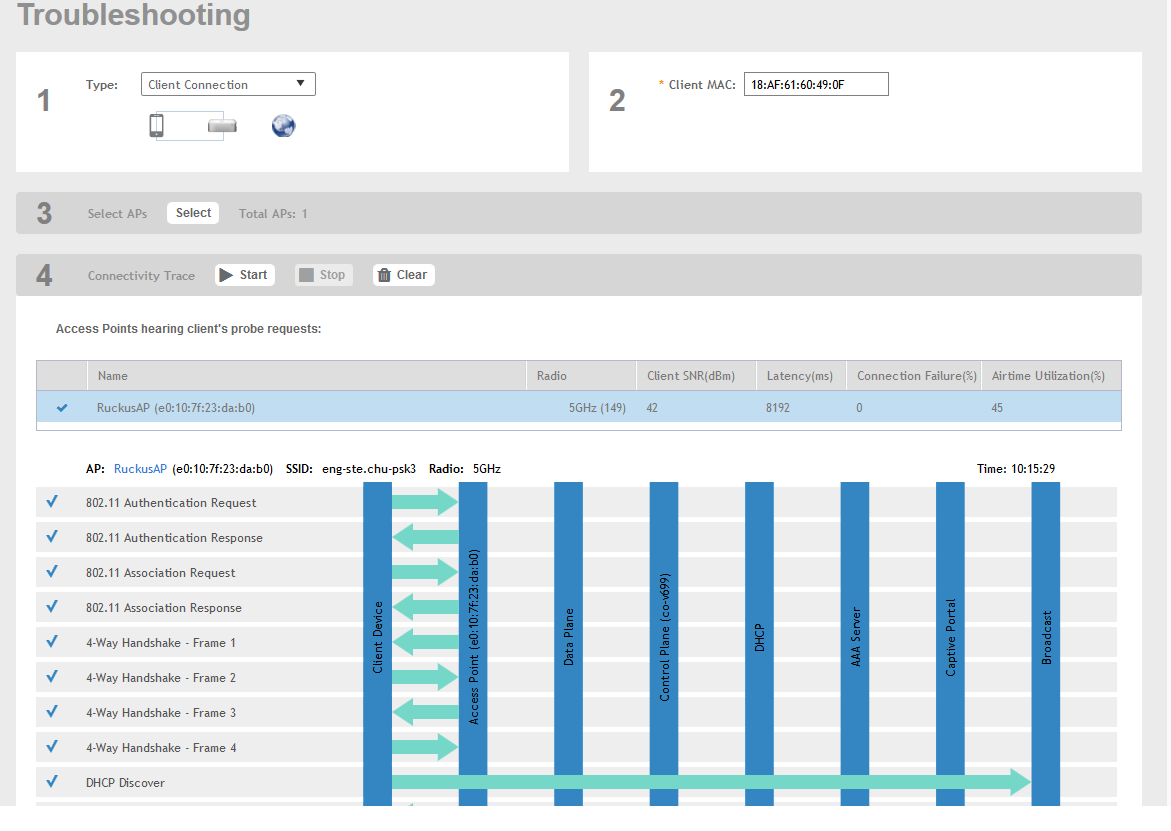Troubleshooting Client Connections
Network administrators can connect to client devices and analyze network connection issues in real time.
Perform the following steps to troubleshoot client connections.
-
Go to
Troubleshooting.
The Troubleshooting page is displayed as shown in the following example.Figure 207 Troubleshooting - Client Connections

- In Type, select Client Connection from the drop-down menu.
-
In
Client MAC, click
 settings, and choose
Historical Client or
Connected Client to view the client list.
settings, and choose
Historical Client or
Connected Client to view the client list.
-
Enter the MAC address of the client device with connectivity issues, or select the client device from the drop-down, which lists the
MAC Address,
Hostname, and
OS Type.
You can search or sort the drop-down list by Client MAC, Hostname, or OS Type.
-
In Select APs, click
Select.
The Select APs page is displayed.
- Select an AP to communicate between the client and the controller, and then click OK.
-
In Connectivity Trace, click
Start.
The controller configures the APs to receive data frames from the target client and relay frames to the controller based on the client filter.
The APs that receive probe requests from the target client are listed in a table, along with the AP's operating channel and the RSSI at which the client’s frames were received. This stage of the connection identifies whether there are acceptable APs for the client to connect to.
The following items are displayed:- AP Name and MAC Address
- Radio: The 2.4 or 5 GHz radio of the AP and the channel number the radio is operating on
- Client SNR: The signal-to-noise ratio received, in dB
- Latency: Time delay in connecting the AP to the client
- Connection Failures: The percentage of AP-client connection attempts that failed
- Airtime Utilization: The percentage of air time that was used by the client to transfer data
At this stage, the tool displays the statuses Client is in a discovery state and not currently connected (when the tool starts or when the client is already connected to an AP) and Client is attempting a new connection (when the target client sends an 802.11 authentication request frame to an AP to initiate a connection).
Use the list of APs that communicated with the client to determine whether the client chose the best AP based on signal quality and other health metrics.
When the client sends an 802.11 authentication request frame, a flow diagram depicting different stages of the AP-client connection is initiated. This sends a trigger frame to the AP, and it is highlighted from the list for reporting APs.
The Flow ladder in the diagram shows the step-by-step exchange of information between devices during the connection process. As the steps are completed, colored arrows are displayed when the step depicts a warnings (yellow) or event (for example, red for failure). Typical warning scenarios include time delays or a failed negotiation for an unsupported EAP type. Failure conditions are also highlighted as red arrows, typically when the connection itself fails.
NOTEThe following authentication types are supported:- Open
- PSK (WPA2-Personal)
- 802.1X (PEAP, TTLS, TLS, SIM)
- WISPr
- Click Stop to terminate the connection between the AP and the client.
